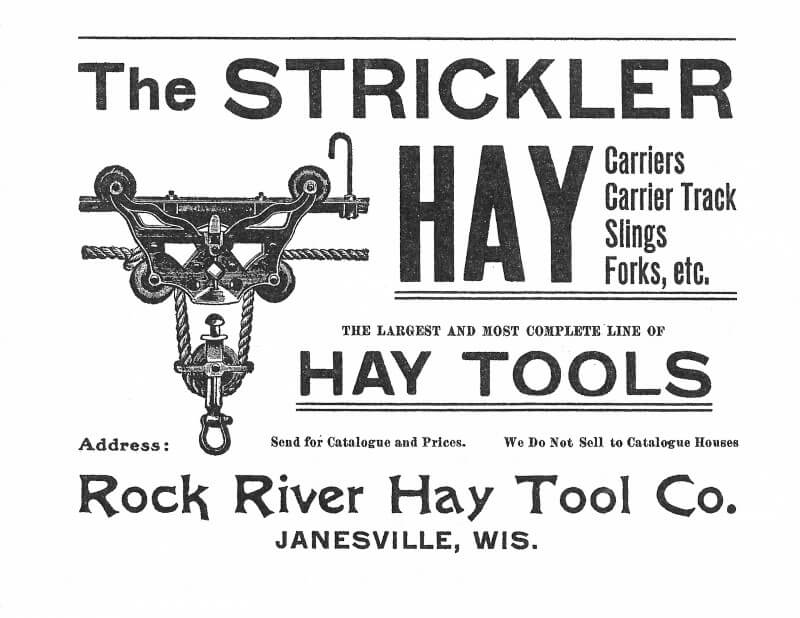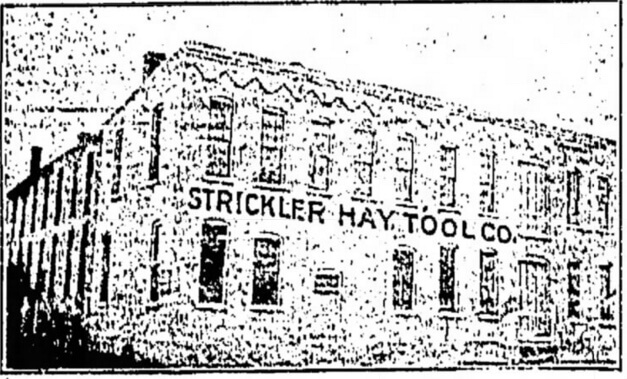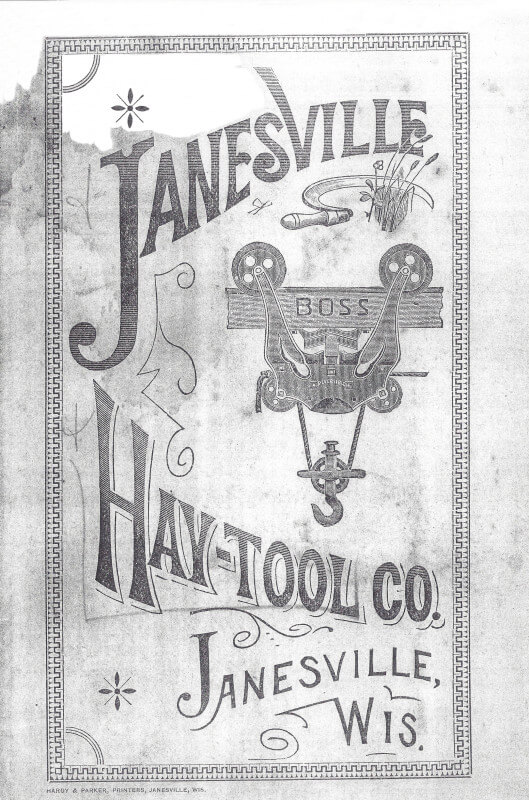
Headquarters:
Janesville, WisconsinAlso sold under the names (if applicable):
History:
JANESVILLE HAY TOOL COMPANY &
THE STRICKLER CONNECTION
William T. Van Kirk came to Janesville, Wisconsin in 1858 and by 1863 was operating a small grocery on his own merit; which was successful for the next 32 years. In company with several other civic leaders, he procured the charter for the electric light plant, the street railway, and the Janesville Hydraulic Company. The group subsequently donated their interests in these several enterprises to further Janesville’s growth and welfare.
As dairy farming began to flourish, Mr. Van Kirk, with a few business friends, organized the Janesville Hay Tool Company in 1884. Among his associates investing in this enterprise were Peter G. Strickler and his son Franklin. Peter had been born in Pennsylvania in 1837, moved to Ohio where he married and his first son, Franklin, was born in 1860. Following service in the Civil War, Peter moved his family to Indiana and by 1880 documents show that Peter and his son Frank, by now a skilled blacksmith, had moved to Rock County, Wisconsin, where they were marketing threshing machines and where Frank was making hay trolleys. A January 1883 newspaper reported that Strickler, Miles & Co. of Janesville had been exhibiting a “most complete hay carrier at recent fairs…a simple device…rendered perfectly reversible, carrying goods as readily one way as the other without any alteration save a knot in either rope.” Frank received the patent on June 19, 1883 for his now famous “Dead Lock” carrier which he had assigned a one-third interest to his father and one-third to a L.E. Miles.
So it was that this small group of entrepreneurs began manufacturing hay handling equipment organized as the Janesville Hay Tool Company. Peter served as President the first year with Mr. Van Kirk as Vice-President and who would succeed Peter in 1885, who sold his interest effective September 1st. G.M. Hanchett stepped in as new VP. A.H. Sheldon was Secretary-Treasurer and Frank Strickler acted as Superintendent and Manager. By 1887 records indicate the flourishing company was manufacturing Strickler’s Reversible Dead-Lock Hay Carrier, touted as “an article of utility in its highest degree of perfection, thereby conferring the greatest possible benefits upon the agricultural community … the best and simplest made, most perfect in action and most durable, is to be found in the fact that so many would-be inventors are trying in every conceivable way to imitate the same – made of the best material and with no springs, and so simple in construction and so easily manipulated that a boy can easily handle it.” The company was also manufacturing double and single horse hay forks, hooks, pulleys and advertising that repairs for same were also available. Wholesale outlets and agencies had been established in NY, NJ, PA, OH, IN, IL, IA, OR and CA.
In a court case decided in May 1895, Janesville Hay Tool Co. successfully defended a letters patent case brought by John M. Boyd with the finding there was no infringement to Boyd’s patent by Strickler’s Dead-Lock patent. Frank Strickler continued in his position as Superintendent/Manager until 1900 when a newspaper account reported that all interests in the Janesville Hay Tool Co. had been sold to Frank Patten of nearby Sycamore, Illinois whose “…intention to establish a new factory for the manufacture of a similar line of goods” that would likely be distributed through Montgomery-Ward outlets.
Frank C. Patten, born in 1867, was the only son of six children born into a well-respected farm family. His parents, who were both rural school teachers in Northern Illinois prior to their marriage, sold the farm when Frank was about 15 and moved to De Kalb where Frank graduated high school in 1885. After a year in the employ of William Deering & Co., Chicago; he returned to De Kalb where he began manufacture of various sundries. His immediate success resulted in expansion of his business in 1887 and by 1889 his enterprise covered an entire city block. Also in 1889, through his initiatives to purchase vacant properties, he began an enterprise to hire contractors and build houses on these properties. He also built school facilities in several neighboring towns and had as many as 350 skilled and unskilled laborers in his employ. It should be noted that a small ad appearing in April 1891 indicates he was marketing “Hay Carriers $3.00 – $4.50.” No brand name mentioned! In 1893 he relocated to nearby Sycamore, Illinois and purchased the Marsh Harvester Plant and former Ellwood Mfg. Co. which he consolidated into the Sycamore Foundry Company where he produced goods under contract such as farm implements, tools and various hardware specialties; employing some 175 workers.
A 1907 biography praises his contributions to the community of Sycamore where he served two years as Mayor. He is also credited with improving the welfare and progress of his native county throughout his career. “His connection with any undertaking insures a prosperous outcome of the same for it is in his nature to carry forward to successful completion whatever he is associated with.” This biography makes no note of Mr. Patten’s purchase of the Janesville Hay Tool Co. in the fall of 1900. We do know that a July 1901 news account reported that Patten planned to move Janesville Hay Tool Co. to Chicago.
Meanwhile, Frank Strickler had applied for a patent on August 16, 1900, subsequently issued on April 2, 1901; for an improved “compressing hay-sling pulley” system. He had also applied for a patent on June 11, 1900 to be assigned to the Janesville Hay Tool Co. for an improved hay-sling lock which was issued on December 8, 1903; two and a half years after he had left the company! An Iron Trade Review article of October 25, 1900, states a new enterprise called the Rock River Machine Co. had incorporated with $15,000 in capital and took over the property of Taylor & Morris Co. in Janesville with R.H. Morris, president; Geo. Marsden, V-P; and Frank Strickler, secy-treasurer. The article states they would manufacture heavy shears and punches. We also know from other advertising of the period that Frank was marketing hay carriers, track, slings and forks under the Rock River Machine Co. name well into 1902 when a May news article reported that Frank, as proprietor of Rock River Hay Tool Co. “had purchased the rights of Rock River Machine in the Strickler hay tool business and will conduct the business himself in the future.” Newspapers had reported that facilities of Rock River Machine were destroyed by fire on February 18, 1902 and would not be rebuilt due to being underinsured.
 Retailers around the country at this time were alarmed that manufacturers providing wholesale goods to department store and catalogue outlets were doing so at prices retailers could not compete with. A newspaper account of a meeting between the Minnesota Hardware Dealers Association, their national contingent and the National Association of Jobbers and Manufacturers reports that a “representative of a Janesville, Wis., hay tool firm was present to assure … he did not furnish tools to a catalogue house in Chicago. His denials were most emphatic … He finally offered to give $500 to the association if it could be proven that his organization had anything to do with the catalogue house.” It is interesting to note that this meeting took place on February 28, 1902 – ten days after the fire which destroyed Rock River Machine Co. One would understand that Frank Strickler was the only one who would have been representing a hay tool company from Janesville at that time. Also, it is public knowledge that Frank Patten had long been publicly contracting with Montgomery Ward in Chicago to supply implements and tools on a wholesale basis. This offers good insight on Mr. Strickler and at a time when he must have been putting things back together from the fire. Another note of interest, the 1903 Farm Implement Buyer’s Guide not only lists the Rock River Hay Tool Co. with Strickler’s hay tools, but also lists Frank Patten’s Janesville Hay Tool Co. in Chicago as marketing the Dead Lock carrier.
Retailers around the country at this time were alarmed that manufacturers providing wholesale goods to department store and catalogue outlets were doing so at prices retailers could not compete with. A newspaper account of a meeting between the Minnesota Hardware Dealers Association, their national contingent and the National Association of Jobbers and Manufacturers reports that a “representative of a Janesville, Wis., hay tool firm was present to assure … he did not furnish tools to a catalogue house in Chicago. His denials were most emphatic … He finally offered to give $500 to the association if it could be proven that his organization had anything to do with the catalogue house.” It is interesting to note that this meeting took place on February 28, 1902 – ten days after the fire which destroyed Rock River Machine Co. One would understand that Frank Strickler was the only one who would have been representing a hay tool company from Janesville at that time. Also, it is public knowledge that Frank Patten had long been publicly contracting with Montgomery Ward in Chicago to supply implements and tools on a wholesale basis. This offers good insight on Mr. Strickler and at a time when he must have been putting things back together from the fire. Another note of interest, the 1903 Farm Implement Buyer’s Guide not only lists the Rock River Hay Tool Co. with Strickler’s hay tools, but also lists Frank Patten’s Janesville Hay Tool Co. in Chicago as marketing the Dead Lock carrier.
On August 6, 1901 Frank C. Patten and Gunder Haugen, both of Sycamore, were granted a hay carrier patent “specifically to improvements in the tripping and latching mechanism of carriers.” On August 10, 1909 a patent was issued to Frank Strickler for an entirely different carrier than his Dead Lock. This carrier was designed having a throat with two grapples which would grab the drop pulley without having a registering head. This apparently resulted in two infringement suits brought against Strickler by Louden Machinery Co. which were decided on March 7, 1911 with decree for Strickler in the first case and for Louden in the second – judged valid but without costs for or against either party.
At some point, during the 1904-05 period, Frank Strickler apparently renamed the enterprise known as Rock River Hay Tool Co. to Strickler Hay Tool Company. The Implement Blue Book for 1909 and 1910 lists him as “Janesville – Strickler Hay Tool Co.” We see advertising under that name in 1911 and 1915. Blue Book listings in 1919 and 1920 show him as Strickler Hay Tool Co. One business journal of that period cites Strickler Hay Tool Co., “manufacturer of hay carriers, hay forks, and cow stanchions.” Frank Strickler had received a patent September 26, 1916 for a cow stanchion which was an improvement to quickly adjust for different size cattle and with an improved latch which could be released from either side.
 On November 6, 1919 trade papers announced that the Hudson Manufacturing Company of Minneapolis, Minnesota had acquired the major interest in the Strickler Hay Tool Co. with a capital stock of $200,000. In addition to the hay tools then in production; the plant was to be “expanded to enhance production of power farm machinery, besides hay tools.” It was further reported that Frank B. Strickler, C.L. Cox and John (Jay) Charles Strickler (Frank’s brother), who were then respectively president, secretary and superintendent of the Strickler concern, would remain with the Hudson company to manage the hay tool production end of the business. A history of the Hudson company documents that following purchase of the Strickler company “which manufactured a line of hay tools and accessories… facilities were moved to De Pere, Wis., where it was combined with production of other barn equipment.” Frank Strickler died in 1927 and Jay, his much younger brother, died in 1962.
On November 6, 1919 trade papers announced that the Hudson Manufacturing Company of Minneapolis, Minnesota had acquired the major interest in the Strickler Hay Tool Co. with a capital stock of $200,000. In addition to the hay tools then in production; the plant was to be “expanded to enhance production of power farm machinery, besides hay tools.” It was further reported that Frank B. Strickler, C.L. Cox and John (Jay) Charles Strickler (Frank’s brother), who were then respectively president, secretary and superintendent of the Strickler concern, would remain with the Hudson company to manage the hay tool production end of the business. A history of the Hudson company documents that following purchase of the Strickler company “which manufactured a line of hay tools and accessories… facilities were moved to De Pere, Wis., where it was combined with production of other barn equipment.” Frank Strickler died in 1927 and Jay, his much younger brother, died in 1962.
SO: Who built and marketed the “no name” trolley with the “FP” part number clearly marked? Do we agree the FP stands for Frank Patten? Those trolleys also depict the letters “W & S” and “W S & C.” To date, no data has been found to account for these designations; although many versions of these were produced during the period.
WHAT became of Frank Patten and the Janesville Hay Tool Co. which he moved to Chicago? In April 1906 all of Patten’s assets were placed in receivership and he faced bankruptcy proceedings on July 9th with liabilities of some $424,000 and assets of $402,000; hardly serious by today’s values! Patten must have been a man of great initiative as a July 1909 newspaper describes him as a 45 year-old broker and real estate dealer – then arrested on a larceny charge. Later, in 1912, he was arrested for fraud on a land deal in Quincy, Illinois! Crippled by a fall in 1928 he retired to his home in DeKalb where he passed away in 1939.
Article written by HTCA member Dennis Mcgrew

